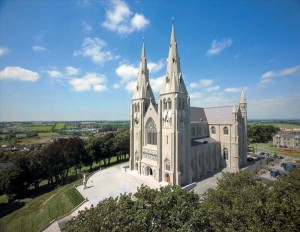The maidens, as if with one voice and one heart, said: “Teach us most carefully how we may believe in the Heavenly King; show us how we may behold Him face to face, and we will do whatsoever you shall say to us.”
And when he had instructed tham he said to them: “Do you believe that by baptism you put off the sin inherited from the first parents.”
They answered: “We believe.”
“Do you believe in penance after sin?”
“We believe.”
“Do you believe in life after death?” Do you believe in resurrection on the Day of Judgment?”
“We believe.”
“Do you believe in the unity of the Church?”
“We believe.”
Then they were baptized, and were clothed in white garments. And they besought that they might behold the face of Christ. And the saint said to them: “You cannot see the face of Christ unless you taste death, and unless you receive the Sacrifice.” They answered: “Give us the Sacrifice, so that we may be able to behold our Spouse.” And the ancient narrative adds: “when they received the Eucharist of God, they slept in death, and they were placed upon a couch, arrayed in their white baptismal robes.”
In 440 St. Patrick entered on the special work of the conversion of Ulster. Under the following year, the ancient annalists relate a wonderful spread of the Faith throughout the province. In 444 a site for a church was granted at Armagh by Daire, the chieftain of the district. It was in a valley at the foot of a hill, but the saint was not content. He had special designs in his heart for that district, and at length the chieftain told him to select in his territory any site he would deem most suitable for his religious purpose. St. Patrick chose that beautiful hill on which the old cathedral of Armagh stands. As he was marking out the church with his companions, they came upon a doe and fawn, and the saint’s companions would kill them for food; but St. Patrick would not allow them to do so, and, taking the fawn upon his shoulders, and followed by the doe, he proceeded to a neighboring hill, and laid down the fawn, and announced that there, in future times, great glory would be given to the Most High. It was precisely upon that hill thus fixed by St. Patrick that, a few years ago, there was solemnly dedicated the new and beautiful Catholic cathedral of Armagh. A representative of the Holy See presided on the occasion, and hundreds of priests and bishops were gathered there; and, indeed, it might truly be said, the whole Irish race on that occasion offered up that glorious cathedral to the Most High as tribute to their united faith and piety, and their never-failing love of God.

Catholic cathedral of Armagh
From Ulster St. Patrick probably proceeded to Meath to consolidate the organization of the communities there, and thence he continued his course through Leinster. Two of the saint’s most distinguished companions, St. Auxilius and St. Iserninus, had the rich valley of the Liffey assigned to them. The former’s name is still retained in the church which he founded at Killossy, while the latter is honored as the first Bishop of Kilcullen.
As usual, St. Patrick’s primary care was to gather the ruling chieftains into the fold. At Naas, the royal residence in those days, he baptized two sons of the King of Leinster. Memorials of the saint still abound in the district — the ruins of the ancient church which he founded, his holy well, and the hallowed sites in which the power of God was shown forth in miracles. At Sletty, in the immediate neighborhood of Carlow, St. Fiacc, son of the chief Brehon, Dubthach, was installed as bishop, and for a considerable time continued to be the chief centre of religion for all Leinster.
